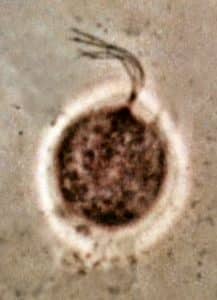Trichomoniasis is a curable sexually transmitted infection (STI) caused by the protozoan Trichomonas vaginalis (TV).
In this article we shall cover the pathophysiology and clinical features of a typical Trichomonas vaginalis infection, current investigations, treatments and how it may impact pregnancy.
Pathophysiology
Trichomonas vaginalis is transmitted through unprotected vaginal sexual intercourse – it is not passed on through oral or anal sex. Although rare, it is also possible for an infected mother to vertically transmit the disease to the neonate at delivery.
Trichomonas vaginalis is an anaerobic flagellated protozoan that can affect the female urethra, vagina and paraurethral glands and the male urethra and underneath the foreskin. Urethral infection is present in nearly all cases and in women there is often infection at more than one site.
TV replicates via binary fission whilst destroying epithelial cells through direct cell contact and by the release of cytotoxins. It also binds host plasma proteins, preventing recognition by the complement pathway. It is thought that this destruction may also lead to an increased risk of contracting HIV.
Risk Factors
The following are risk factors associated with Trichomoniasis, most of which are common to other STIs:
- Multiple sexual partners
- Unprotected sexual intercourse
- A history of other STIs
- Older women are more at risk of TV
Clinical Features
Many cases of TV infection are asymptomatic, especially in men, who often present as a partner of an infected woman. If symptomatic, signs and symptoms usually develop within 28 days following infection.
Female:
Symptoms:
- Offensive vaginal odour
- Abnormal vaginal discharge – thick/thin/frothy and yellow-green
- Itchiness or soreness of the vulva
- Dyspareunia
- Dysuria
Signs:
- Abnormal vaginal discharge – thick/thin/frothy and yellow-green
- Vulvitis
- Vaginitis
- Strawberry cervix – punctate and papilliform appearance
Male:
Symptoms:
- Urethral discharge
- Dysuria
- Urinary frequency
- Pain or itching around the foreskin
Signs:
- Urethral discharge
- Balanoposthitis – inflammation of the glans penis (rare)
Investigations

Figure 1. Trichomonas vaginalis microscopy.
As with all STIs, a thorough history and examination are necessary to determine the likelihood or severity of infection. If TV infection is suspected, specimens are taken to be cultured and sensitivity established or if in a specialist centre, on site microscopy may reveal TV.
- Female:
- High vaginal swab is taken from the posterior fornix during examination or
- Self-administered vaginal swab
- Males:
- Urethral swab or
- First void urine sample
If the patient tests positive for trichomoniasis then contact tracing is required.
It is important to carry out a full STI screen for coexisting infections. Bloods may also be required if there are systemic features of infection.
Management
Trichomoniasis can be managed successfully with anti-protozoan antibiotics. Current guidance for men and non-pregnant, non-breastfeeding women:
- Metronidazole 2g orally in a single dose or
- Metronidazole 400-500mg twice daily for 5-7 days
Alternatives to the recommended regimes:
- Tinidazole 2g orally in a single dose
The patient’s current partner(s) and any sexual partners of the preceding four weeks should also be tested and treated simultaneously.
Patients should be advised to abstain from sexual intercourse whilst being treated or at least one week following the single dose. Test of cure is not necessary unless the patient is not responding to treatment or if they are re-infected.
Full details can be found in the UK national guidelines on the management of Trichomonas vaginalis.
Trichomonas Vaginalis in Pregnancy
In pregnant females, trichomoniasis may carry a risk of premature labour and the baby having a low birth-weight. TV infection at delivery may also predispose to maternal postpartum sepsis. Pregnant women are treated the same way as non-pregnant women however high dose regimes are not recommended during pregnancy. Metronidazole can also affect the taste of breast milk so high dose regimes are not advised or if a single dose is used, breastfeeding should be avoided for 12-24 hours.
